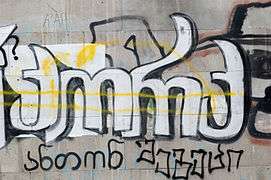Graffiti
Graffiti (both singular and plural; the singular graffito is very rare in English except in archeology)[1][2][3] is writing or drawings made on a wall or other surface, usually without permission and within public view.[2][3] Graffiti ranges from simple written words to elaborate wall paintings, and has existed since ancient times, with examples dating back to ancient Egypt, ancient Greece, and the Roman Empire.[4]
In modern times, spray paint and marker pens have become commonly used graffiti materials, and there are many different types and styles of graffiti; it is a rapidly developing art form.
Graffiti is a controversial subject. In most countries, marking or painting property without permission is considered by property owners and civic authorities as defacement and vandalism, which is a punishable crime, citing the use of graffiti by street gangs to mark territory or to serve as an indicator of gang-related activities.[5] Graffiti has become visualized as a growing urban "problem" for many cities in industrialized nations, spreading from the New York City subway system in the early 1970s to the rest of the United States and Europe and other world regions.[6] On the other hand, graffiti artists, particularly marginalized artists with no access to mainstream media, resist this viewpoint to display their art or political views in public locations.
The life of artist Jean-Michel Basquiat illustrates the subjective nature of the public response to graffiti. He started out as a street graffiti artist chased by authorities, and later one of his paintings sold for over $100,000,000.
Etymology

Both "graffiti" and its occasional singular form "graffito" are from the Italian word graffiato ("scratched"). "Graffiti" is applied in art history to works of art produced by scratching a design into a surface. A related term is "sgraffito",[7] which involves scratching through one layer of pigment to reveal another beneath it. This technique was primarily used by potters who would glaze their wares and then scratch a design into it. In ancient times graffiti were carved on walls with a sharp object, although sometimes chalk or coal were used. The word originates from Greek γράφειν—graphein—meaning "to write".[8]
History

The term graffiti referred to the inscriptions, figure drawings, and such, found on the walls of ancient sepulchres or ruins, as in the Catacombs of Rome or at Pompeii. Use of the word has evolved to include any graphics applied to surfaces in a manner that constitutes vandalism.[9]
The only known source of the Safaitic language, an ancient form of Arabic, is from graffiti: inscriptions scratched on to the surface of rocks and boulders in the predominantly basalt desert of southern Syria, eastern Jordan and northern Saudi Arabia. Safaitic dates from the first century BC to the fourth century AD.[10][11]
Modern-style graffiti
The first known example of "modern style" graffiti survives in the ancient Greek city of Ephesus (in modern-day Turkey). Local guides say it is an advertisement for prostitution. Located near a mosaic and stone walkway, the graffiti shows a handprint that vaguely resembles a heart, along with a footprint, a number, and a carved image of a woman's head.
The ancient Romans carved graffiti on walls and monuments, examples of which also survive in Egypt. Graffiti in the classical world had different connotations than they carry in today's society concerning content. Ancient graffiti displayed phrases of love declarations, political rhetoric, and simple words of thought, compared to today's popular messages of social and political ideals.[12] The eruption of Vesuvius preserved graffiti in Pompeii, which includes Latin curses, magic spells, declarations of love, insults, alphabets, political slogans, and famous literary quotes, providing insight into ancient Roman street life. One inscription gives the address of a woman named Novellia Primigenia of Nuceria, a prostitute, apparently of great beauty, whose services were much in demand. Another shows a phallus accompanied by the text, mansueta tene ("handle with care").
Disappointed love also found its way onto walls in antiquity:
Quisquis amat. veniat. Veneri volo frangere costas
fustibus et lumbos debilitare deae.
Si potest illa mihi tenerum pertundere pectus
quit ego non possim caput illae frangere fuste?
Whoever loves, go to hell. I want to break Venus's ribs
with a club and deform her hips.
If she can break my tender heart
why can't I hit her over the head?
Ancient tourists visiting the 5th-century citadel at Sigiriya in Sri Lanka scribbled over 1800 individual graffiti there between the 6th and 18th centuries. Etched on the surface of the Mirror Wall, they contain pieces of prose, poetry, and commentary. The majority of these visitors appear to have been from the elite of society: royalty, officials, professions, and clergy. There were also soldiers, archers, and even some metalworkers. The topics range from love to satire, curses, wit, and lament. Many demonstrate a very high level of literacy and a deep appreciation of art and poetry.[14] Most of the graffiti refer to the frescoes of semi-nude females found there. One reads:
Wet with cool dew drops
fragrant with perfume from the flowers
came the gentle breeze
jasmine and water lily
dance in the spring sunshine
side-long glances
of the golden-hued ladies
stab into my thoughts
heaven itself cannot take my mind
as it has been captivated by one lass
among the five hundred I have seen here.[15]
Among the ancient political graffiti examples were Arab satirist poems. Yazid al-Himyari, an Umayyad Arab and Persian poet, was most known for writing his political poetry on the walls between Sajistan and Basra, manifesting a strong hatred towards the Umayyad regime and its walis, and people used to read and circulate them very widely.[16]
Level of literacy often evident in graffiti
Historic forms of graffiti have helped gain understanding into the lifestyles and languages of past cultures. Errors in spelling and grammar in these graffiti offer insight into the degree of literacy in Roman times and provide clues on the pronunciation of spoken Latin. Examples are CIL IV, 7838: Vettium Firmum / aed[ilem] quactiliar[ii] [sic] rog[ant]. Here, "qu" is pronounced "co". The 83 pieces of graffiti found at CIL IV, 4706-85 are evidence of the ability to read and write at levels of society where literacy might not be expected. The graffiti appear on a peristyle which was being remodeled at the time of the eruption of Vesuvius by the architect Crescens. The graffiti were left by both the foreman and his workers. The brothel at CIL VII, 12, 18–20 contains more than 120 pieces of graffiti, some of which were the work of the prostitutes and their clients. The gladiatorial academy at CIL IV, 4397 was scrawled with graffiti left by the gladiator Celadus Crescens (Suspirium puellarum Celadus thraex: "Celadus the Thracian makes the girls sigh.")
Another piece from Pompeii, written on a tavern wall about the owner of the establishment and his questionable wine:
Landlord, may your lies malign
Bring destruction on your head!
You yourself drink unmixed wine,
Water [do you] sell [to] your guests instead.[17]
It was not only the Greeks and Romans who produced graffiti: the Maya site of Tikal in Guatemala contains examples of ancient Maya graffiti. Viking graffiti survive in Rome and at Newgrange Mound in Ireland, and a Varangian scratched his name (Halvdan) in runes on a banister in the Hagia Sophia at Constantinople. These early forms of graffiti have contributed to the understanding of lifestyles and languages of past cultures.
Graffiti, known as Tacherons, were frequently scratched on Romanesque Scandinavian church walls.[18] When Renaissance artists such as Pinturicchio, Raphael, Michelangelo, Ghirlandaio, or Filippino Lippi descended into the ruins of Nero's Domus Aurea, they carved or painted their names and returned to initiate the grottesche style of decoration.[19][20]
There are also examples of graffiti occurring in American history, such as Independence Rock, a national landmark along the Oregon Trail.[21]
Later, French soldiers carved their names on monuments during the Napoleonic campaign of Egypt in the 1790s.[22] Lord Byron's survives on one of the columns of the Temple of Poseidon at Cape Sounion in Attica, Greece.[23]
- Ancient graffiti
 Ancient Pompeii graffito caricature of a politician
Ancient Pompeii graffito caricature of a politician.jpg) Ironic wall inscription commenting on boring graffiti
Ironic wall inscription commenting on boring graffiti Satirical Alexamenos graffito, possibly the earliest known representation of Jesus
Satirical Alexamenos graffito, possibly the earliest known representation of Jesus Graffiti, Church of the Holy Sepulchre, Jerusalem
Graffiti, Church of the Holy Sepulchre, Jerusalem Crusader graffiti in the Church of the Holy Sepulchre
Crusader graffiti in the Church of the Holy Sepulchre

Contemporary graffiti

Contemporary graffiti style has been heavily influenced by hip hop culture [24] and the myriad international styles derived from Philadelphia and New York City Subway graffiti, however, there are many other traditions of notable graffiti in the twentieth century. Graffiti have long appeared on building walls, in latrines, railroad boxcars, subways, and bridges.
The oldest known example of modern graffiti are the "monikers" found on traincars created by hobos and railworkers since the late 1800s. The Bozo Texino monikers were documented by filmmaker Bill Daniel in his 2005 film, Who is Bozo Texino?.[25][26]
Some graffiti have their own poignancy. In World War II, an inscription on a wall at the fortress of Verdun was seen as an illustration of the US response twice in a generation to the wrongs of the Old World:[27][28]
Austin White – Chicago, Ill – 1918
Austin White – Chicago, Ill – 1945
This is the last time I want to write my name here.
During World War II and for decades after, the phrase "Kilroy was here" with an accompanying illustration was widespread throughout the world, due to its use by American troops and ultimately filtering into American popular culture. Shortly after the death of Charlie Parker (nicknamed "Yardbird" or "Bird"), graffiti began appearing around New York with the words "Bird Lives".[29] The student protests and general strike of May 1968 saw Paris bedecked in revolutionary, anarchistic, and situationist slogans such as L'ennui est contre-révolutionnaire ("Boredom is counterrevolutionary") expressed in painted graffiti, poster art, and stencil art. At the time in the US, other political phrases (such as "Free Huey" about Black Panther Huey Newton) became briefly popular as graffiti in limited areas, only to be forgotten. A popular graffito of the early 1970s was "Dick Nixon Before He Dicks You", reflecting the hostility of the youth culture to that US president.
- World War II graffiti
 Soldier with tropical fantasy graffiti (1943–1944)
Soldier with tropical fantasy graffiti (1943–1944) Soviet Army graffiti in the ruins of the Reichstag in Berlin (1945)
Soviet Army graffiti in the ruins of the Reichstag in Berlin (1945)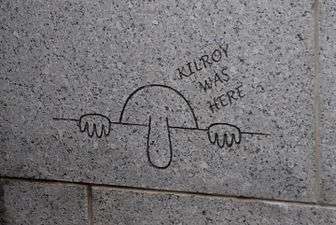 Permanent engraving of Kilroy on the World War II Memorial in Washington, D.C.
Permanent engraving of Kilroy on the World War II Memorial in Washington, D.C.
Advent of aerosol paint
Rock and roll graffiti is a significant subgenre. A famous graffito of the twentieth century was the inscription in the London tube reading "Clapton is God" in a link to the guitarist Eric Clapton. The phrase was spray-painted by an admirer on a wall in an Islington station on the Underground in the autumn of 1967. The graffito was captured in a photograph, in which a dog is urinating on the wall.
Graffiti also became associated with the anti-establishment punk rock movement beginning in the 1970s. Bands such as Black Flag and Crass (and their followers) widely stenciled their names and logos, while many punk night clubs, squats, and hangouts are famous for their graffiti. In the late 1980s the upside down Martini glass that was the tag for punk band Missing Foundation was the most ubiquitous graffito in lower Manhattan
- Early spray-painted graffiti
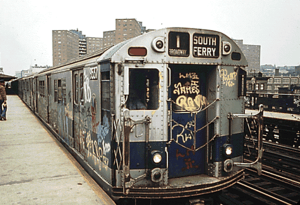 New York City Subway trains were covered in graffiti (1973)
New York City Subway trains were covered in graffiti (1973) Graffiti in Chicago (1973)
Graffiti in Chicago (1973)
Spread of hip hop culture
In 1979, graffitists Lee Quiñones and Fab 5 Freddy were given a gallery opening in Rome by art dealer Claudio Bruni. For many outside of New York, it was their first encounter with their art form. Fab 5 Freddy's friendship with Debbie Harry influenced Blondie's single "Rapture" (Chrysalis, 1981), the video of which featured Jean-Michel Basquiat, and offered many their first glimpse of a depiction of elements of graffiti in hip hop culture. JaJaJa toured Germany, Switzerland, Belgium, and Holland with a large graffiti canvas as a backdrop.[30] Charlie Ahearn's independently released fiction film Wild Style (Wild Style, 1983), the early PBS documentary Style Wars (1983), hit songs such as "The Message" and "Planet Rock" and their accompanying music videos (both 1982) contributed to a growing interest outside New York in all aspects of hip hop.[24]
Style Wars depicted not only famous graffitists such as Skeme, Dondi, MinOne, and ZEPHYR, but also reinforced graffiti's role within New York's emerging hip-hop culture by incorporating famous early break-dancing groups such as Rock Steady Crew into the film and featuring rap in the soundtrack. Although many officers of the New York City Police Department found this film to be controversial, Style Wars is still recognized as the most prolific film representation of what was going on within the young hip hop culture of the early 1980s.[31] Fab 5 Freddy and Futura 2000 took hip hop graffiti to Paris and London as part of the New York City Rap Tour in 1983.[32] Hollywood also paid attention, consulting writers such as PHASE 2 as it depicted the culture and gave it international exposure in movies such as Beat Street (Orion, 1984).
Stencil graffiti emerges
This period also saw the emergence of the new stencil graffiti genre. Some of the first examples were created in 1981 by graffitists Blek le Rat in Paris, in 1982 by Jef Aerosol in Tours (France); by 1985 stencils had appeared in other cities including New York City, Sydney, and Melbourne, where they were documented by American photographer Charles Gatewood and Australian photographer Rennie Ellis.[33]
- Stencil graffiti
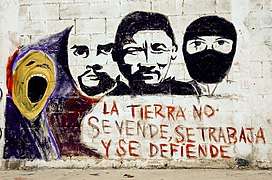

Commercialization and entrance into mainstream pop culture
With the popularity and legitimization of graffiti has come a level of commercialization. In 2001, computer giant IBM launched an advertising campaign in Chicago and San Francisco which involved people spray painting on sidewalks a peace symbol, a heart, and a penguin (Linux mascot), to represent "Peace, Love, and Linux." IBM paid Chicago and San Francisco collectively US$120,000 for punitive damages and clean-up costs.[34][35]
In 2005, a similar ad campaign was launched by Sony and executed by its advertising agency in New York, Chicago, Atlanta, Philadelphia, Los Angeles, and Miami, to market its handheld PSP gaming system. In this campaign, taking notice of the legal problems of the IBM campaign, Sony paid building owners for the rights to paint on their buildings "a collection of dizzy-eyed urban kids playing with the PSP as if it were a skateboard, a paddle, or a rocking horse".[35]
Advocates
Marc Ecko, an urban clothing designer, has been an advocate of graffiti as an art form during this period, stating that "Graffiti is without question the most powerful art movement in recent history and has been a driving inspiration throughout my career."[36]
Graffiti have become a common stepping stone for many members of both the art and design communities in North America and abroad. Within the United States graffitists such as Mike Giant, Pursue, Rime, Noah, and countless others have made careers in skateboard, apparel, and shoe design for companies such as DC Shoes, Adidas, Rebel8, Osiris, or Circa[37] Meanwhile, there are many others such as DZINE, Daze, Blade, and The Mac who have made the switch to being gallery artists, often not even using their initial medium, spray paint.[37]
Global developments
South America
Tristan Manco wrote that Brazil "boasts a unique and particularly rich, graffiti scene ... [earning] it an international reputation as the place to go for artistic inspiration." Graffiti "flourishes in every conceivable space in Brazil's cities." Artistic parallels "are often drawn between the energy of São Paulo today and 1970s New York." The "sprawling metropolis," of São Paulo has "become the new shrine to graffiti;" Manco alludes to "poverty and unemployment ... [and] the epic struggles and conditions of the country's marginalised peoples," and to "Brazil's chronic poverty," as the main engines that "have fuelled a vibrant graffiti culture." In world terms, Brazil has "one of the most uneven distributions of income. Laws and taxes change frequently." Such factors, Manco argues, contribute to a very fluid society, riven with those economic divisions and social tensions that underpin and feed the "folkloric vandalism and an urban sport for the disenfranchised," that is South American graffiti art.[38]

Prominent Brazilian graffitists include Os Gêmeos, Boleta, Nunca, Nina, Speto, Tikka, and T.Freak.[39] Their artistic success and involvement in commercial design ventures[40] has highlighted divisions within the Brazilian graffiti community between adherents of the cruder transgressive form of pichação and the more conventionally artistic values of the practitioners of grafite.[41]
Middle East
Graffiti in the Middle East is emerging slowly, with pockets of taggers operating in the various 'Emirates' of the United Arab Emirates, in Israel, and in Iran. The major Iranian newspaper Hamshahri has published two articles on illegal writers in the city with photographic coverage of Iranian artist A1one's works on Tehran walls. Tokyo-based design magazine, PingMag, has interviewed A1one and featured photographs of his work.[42] The Israeli West Bank barrier has become a site for graffiti, reminiscent in this sense of the Berlin Wall. Many graffitists in Israel come from other places around the globe, such as JUIF from Los Angeles and DEVIONE from London. The religious reference "נ נח נחמ נחמן מאומן" ("Na Nach Nachma Nachman Meuman") is commonly seen in graffiti around Israel.
Southeast Asia
There are also a large number of graffiti influences in Southeast Asian countries that mostly come from modern Western culture, such as Malaysia, where graffiti have long been a common sight in Malaysia's capital city, Kuala Lumpur. Since 2010, the country has begun hosting a street festival to encourage all generations and people from all walks of life to enjoy and encourage Malaysian street culture.[43]
- Graffiti around the world
.2.jpg)

- Graffiti in Ho Chi Minh City, Vietnam
- Graffiti art in Kuala Lumpur, Malaysia
 Graffiti in Yogyakarta, Indonesia
Graffiti in Yogyakarta, Indonesia
Characteristics of common graffiti
Methods and production
The modern-day graffitists can be found with an arsenal of various materials that allow for a successful production of a piece.[44] This includes such techniques as scribing. However, spray paint in aerosol cans is the number one medium for graffiti. From this commodity comes different styles, technique, and abilities to form master works of graffiti. Spray paint can be found at hardware and art stores and comes in virtually every color.
Stencil graffiti is created by cutting out shapes and designs in a stiff material (such as cardboard or subject folders) to form an overall design or image. The stencil is then placed on the "canvas" gently and with quick, easy strokes of the aerosol can, the image begins to appear on the intended surface.
Modern experimentation

Modern graffiti art often incorporates additional arts and technologies. For example, Graffiti Research Lab has encouraged the use of projected images and magnetic light-emitting diodes (throwies) as new media for graffitists. Yarnbombing is another recent form of graffiti. Yarnbombers occasionally target previous graffiti for modification, which had been avoided among the majority of graffitists.
Tagging


Some of the most common styles of graffiti have their own names. A tag is the most basic writing of an artist's name; it is simply a handstyle. A graffiti writer's tag is his or her personalized signature. Tagging is often the example given when opponents of graffiti refer to any acts of handstyle graffiti writing (it is by far the most common form of graffiti). Tags can contain subtle and sometimes cryptic messages, and may incorporate the artist's crew initials or other letters.
One form of tagging, known as pissing, involves taking a refillable fire-extinguisher and replacing the contents with paint, allowing for tags as high as approximately 20 feet (6.1 m). Aiming and keeping a handstyle steady in this form of tagging is very difficult, usually coming out wavy and sloppy.
Another form is the throw-up, also known as a bombing, which is normally painted very quickly with two or three colors, sacrificing aesthetics for speed. Throw-ups can also be outlined on a surface with one color. A piece is a more elaborate representation of the artist's name, incorporating more stylized letters, usually incorporating a much larger range of colors. This is more time-consuming and increases the likelihood of the artist getting caught.
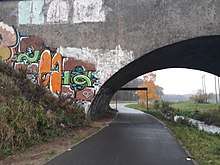
A blockbuster or roller is a large piece, almost always done in a block-shaped style, done simply to cover a large area solidly with two contrasting colors, sometimes with the whole purpose of blocking other writers from painting on the same wall. These are usually accomplished with extended paint rollers and gallons of cheap exterior paint.
A more complex style is wildstyle, a form of graffiti usually involving interlocking letters and connecting points. These pieces are often harder to read by non-graffitists as the letters merge into one another in an often-undecipherable manner.
Some artists also use self-adhesive stickers as a quick way to do catch ups. While certain critics from within graffiti culture consider this lazy, stickers can be quite detailed in their own right and often, are used in conjunction with other materials. Sticker tags are commonly executed on blank postage stickers, as these can easily be acquired with no cost on the writer's part.
Many graffitists believe that doing complex pieces involves too great an investment of time to justify the practice. Doing a piece can take (depending on experience and size) from 30 minutes to months on end, as was the case for Saber MSK while working on the world's largest graffiti piece on the LA river.
Another graffitists can go over a piece in a matter of minutes with a simple throw-up. This was exemplified by the writer "CAP" in the documentary Style Wars, who, other writers complain, ruins pieces with his quick throw ups. This became known as capping and often is done when there is a "beef", or conflict between writers.
A number of recent examples of graffiti make use of hashtags.[45][46]
Uses
Theories on the use of graffiti by avant-garde artists have a history dating back at least to the Asger Jorn, who in 1962 painting declared in a graffiti-like gesture "the avant-garde won't give up".[47]
Many contemporary analysts and even art critics have begun to see artistic value in some graffiti and to recognize it as a form of public art. According to many art researchers, particularly in the Netherlands and in Los Angeles, that type of public art is, in fact an effective tool of social emancipation or, in the achievement of a political goal.[48]
In times of conflict, such murals have offered a means of communication and self-expression for members of these socially, ethnically, or racially divided communities, and have proven themselves as effective tools in establishing dialog and thus, of addressing cleavages in the long run. The Berlin Wall was also extensively covered by graffiti reflecting social pressures relating to the oppressive Soviet rule over the GDR.
Many artists involved with graffiti are also concerned with the similar activity of stenciling. Essentially, this entails stenciling a print of one or more colors using spray-paint. Recognized while exhibiting and publishing several of her coloured stencils and paintings portraying the Sri Lankan Civil War and urban Britain in the early 2000s, graffitists Mathangi Arulpragasam, aka M.I.A., has also become known for integrating her imagery of political violence into her music videos for singles "Galang" and "Bucky Done Gun", and her cover art. Stickers of her artwork also often appear around places such as London in Brick Lane, stuck to lamp posts and street signs, she having become a muse for other graffitists and painters worldwide in cities including Seville.
Personal expression
Many graffitists choose to protect their identities and remain anonymous or to hinder prosecution.
With the commercialization of graffiti (and hip hop in general), in most cases, even with legally painted "graffiti" art, graffitists tend to choose anonymity. This may be attributed to various reasons or a combination of reasons. Graffiti still remains the one of four hip hop elements that is not considered "performance art" despite the image of the "singing and dancing star" that sells hip hop culture to the mainstream. Being a graphic form of art, it might also be said that many graffitists still fall in the category of the introverted archetypal artist.
Banksy is one of the world's most notorious and popular street artists who continues to remain faceless in today's society.[49] He is known for his political, anti-war stencil art mainly in Bristol, England, but his work may be seen anywhere from Los Angeles to Palestine. In the UK, Banksy is the most recognizable icon for this cultural artistic movement and keeps his identity a secret to avoid arrest. Much of Banksy's artwork may be seen around the streets of London and surrounding suburbs, although he has painted pictures throughout the world, including the Middle East, where he has painted on Israel's controversial West Bank barrier with satirical images of life on the other side. One depicted a hole in the wall with an idyllic beach, while another shows a mountain landscape on the other side. A number of exhibitions also have taken place since 2000, and recent works of art have fetched vast sums of money. Banksy's art is a prime example of the classic controversy: vandalism vs. art. Art supporters endorse his work distributed in urban areas as pieces of art and some councils, such as Bristol and Islington, have officially protected them, while officials of other areas have deemed his work to be vandalism and have removed it.
Pixnit is another artist who chooses to keep her identity from the general public.[50] Her work focuses on beauty and design aspects of graffiti as opposed to Banksy's anti-government shock value. Her paintings are often of flower designs above shops and stores in her local urban area of Cambridge, Massachusetts. Some store owners endorse her work and encourage others to do similar work as well. "One of the pieces was left up above Steve's Kitchen, because it looks pretty awesome"- Erin Scott, the manager of New England Comics in Allston, Massachusetts.
- Personal graffiti
.jpg) Drawing at Temple of Philae, Egypt depicting three men with rods, or staves.
Drawing at Temple of Philae, Egypt depicting three men with rods, or staves..jpg) Inscription in Pompeii lamenting a frustrated love, "Whoever loves, let him flourish, let him perish who knows not love, let him perish twice over whoever forbids love."
Inscription in Pompeii lamenting a frustrated love, "Whoever loves, let him flourish, let him perish who knows not love, let him perish twice over whoever forbids love."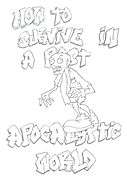 Post-apocalyptic despair
Post-apocalyptic despair
Radical and political
.jpg)
Graffiti often has a reputation as part of a subculture that rebels against authority, although the considerations of the practitioners often diverge and can relate to a wide range of attitudes. It can express a political practice and can form just one tool in an array of resistance techniques. One early example includes the anarcho-punk band Crass, who conducted a campaign of stenciling anti-war, anarchist, feminist, and anti-consumerist messages throughout the London Underground system during the late 1970s and early 1980s.[51] In Amsterdam graffiti was a major part of the punk scene. The city was covered with names such as "De Zoot", "Vendex", and "Dr Rat".[52] To document the graffiti a punk magazine was started that was called Gallery Anus. So when hip hop came to Europe in the early 1980s there was already a vibrant graffiti culture.
The student protests and general strike of May 1968 saw Paris bedecked in revolutionary, anarchistic, and situationist slogans such as L'ennui est contre-révolutionnaire ("Boredom is counterrevolutionary") and Lisez moins, vivez plus ("Read less, live more"). While not exhaustive, the graffiti gave a sense of the 'millenarian' and rebellious spirit, tempered with a good deal of verbal wit, of the strikers.
—Sandra "Lady Pink" Fabara[53]
The developments of graffiti art which took place in art galleries and colleges as well as "on the street" or "underground", contributed to the resurfacing in the 1990s of a far more overtly politicized art form in the subvertising, culture jamming, or tactical media movements. These movements or styles tend to classify the artists by their relationship to their social and economic contexts, since, in most countries, graffiti art remains illegal in many forms except when using non-permanent paint. Since the 1990s with the rise of Street Art, a growing number of artists are switching to non-permanent paints and non-traditional forms of painting.[54][55]
Contemporary practitioners, accordingly, have varied and often conflicting practices. Some individuals, such as Alexander Brener, have used the medium to politicize other art forms, and have used the prison sentences enforced on them as a means of further protest.[56] The practices of anonymous groups and individuals also vary widely, and practitioners by no means always agree with each other's practices. For example, the anti-capitalist art group the Space Hijackers did a piece in 2004 about the contradiction between the capitalistic elements of Banksy and his use of political imagery.[57][58]
Territorial graffiti marks urban neighborhoods with tags and logos to differentiate certain groups from others. These images are meant to show outsiders a stern look at whose turf is whose. The subject matter of gang-related graffiti consists of cryptic symbols and initials strictly fashioned with unique calligraphies. Gang members use graffiti to designate membership throughout the gang, to differentiate rivals and associates and, most commonly, to mark borders which are both territorial and ideological.[59]
- Political graffiti around the world

 Wall in Belgrade, Serbia, with the slogan "Vote for Filip Filipović", who was the communist candidate for the mayor of Belgrade (1920)
Wall in Belgrade, Serbia, with the slogan "Vote for Filip Filipović", who was the communist candidate for the mayor of Belgrade (1920) An interpretation of Liberty Leading the People on the separation barrier which runs through Bethlehem
An interpretation of Liberty Leading the People on the separation barrier which runs through Bethlehem WWII bunker near Anhalter Bahnhof (Berlin) with a graffiti inscription Wer Bunker baut, wirft Bomben (those who build bunkers, throw bombs)
WWII bunker near Anhalter Bahnhof (Berlin) with a graffiti inscription Wer Bunker baut, wirft Bomben (those who build bunkers, throw bombs) Graffiti on the train line leading to Central Station in Amsterdam
Graffiti on the train line leading to Central Station in Amsterdam- "Let's JOKK" in Tartu refers to political scandal with the Estonian Reform Party (2012)

- Stencil in Pieksämäki representing former president of Finland, Urho Kekkonen, well known in Finnish popular culture
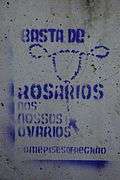 Feminist graffiti in A Coruña, Spain that reads "Enough with rosaries in our ovaries"
Feminist graffiti in A Coruña, Spain that reads "Enough with rosaries in our ovaries" East Timorese protest against Australian petroleum extraction
East Timorese protest against Australian petroleum extraction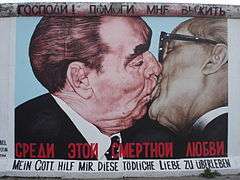
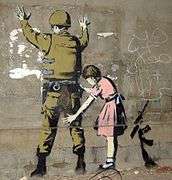 Ironic graffiti in Bethlehem
Ironic graffiti in Bethlehem Berlin Wall: "Anyone who wants to keep the world as it is, does not want it to remain"
Berlin Wall: "Anyone who wants to keep the world as it is, does not want it to remain"
As advertising
Graffiti has been used as a means of advertising both legally and illegally. Bronx-based TATS CRU has made a name for themselves doing legal advertising campaigns for companies such as Coca-Cola, McDonald's, Toyota, and MTV. In the UK, Covent Garden's Boxfresh used stencil images of a Zapatista revolutionary in the hopes that cross referencing would promote their store.
Smirnoff hired artists to use reverse graffiti (the use of high pressure hoses to clean dirty surfaces to leave a clean image in the surrounding dirt) to increase awareness of their product.
- Advertising graffiti
.jpg)

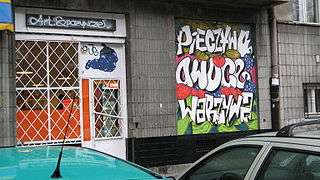 Graffiti as legal advertising on a grocer's shop window in Warsaw, Poland
Graffiti as legal advertising on a grocer's shop window in Warsaw, Poland
Offensive graffiti
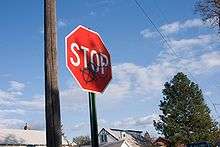
Graffiti may also be used as an offensive expression. This form of graffiti may be difficult to identify, as it is mostly removed by the local authority (as councils which have adopted strategies of criminalization also strive to remove graffiti quickly).[60] Therefore, existing racist graffiti is mostly more subtle and at first sight, not easily recognized as "racist". It can then be understood only if one knows the relevant "local code" (social, historical, political, temporal, and spatial), which is seen as heteroglot and thus a 'unique set of conditions' in a cultural context.[61]
- A spatial code for example, could be that there is a certain youth group in an area that is engaging heavily in racist activities. So, for residents (knowing the local code), a graffiti containing only the name or abbreviation of this gang already is a racist expression, reminding the offended people of their gang activities. Also a graffiti is in most cases, the herald of more serious criminal activity to come.[62] A person who does not know these gang activities would not be able to recognize the meaning of this graffiti. Also if a tag of this youth group or gang is placed on a building occupied by asylum seekers, for example, its racist character is even stronger.
By making the graffiti less explicit (as adapted to social and legal constraints),[63] these drawings are less likely to be removed, but do not lose their threatening and offensive character.[64]
Elsewhere, activists in Russia have used painted caricatures of local officials with their mouths as potholes, to show their anger about the poor state of the roads.[65] In Manchester, England a graffitists painted obscene images around potholes, which often resulted in their being repaired within 48 hours.[66]
Decorative and high art
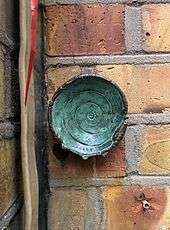
In the early 1980s, the first art galleries to show graffitists to the public were Fashion Moda in the Bronx, Now Gallery and Fun Gallery, both in the East Village, Manhattan.[67][68][69][70]
A 2006 exhibition at the Brooklyn Museum displayed graffiti as an art form that began in New York's outer boroughs and reached great heights in the early 1980s with the work of Crash, Lee, Daze, Keith Haring, and Jean-Michel Basquiat. It displayed 22 works by New York graffitists, including Crash, Daze, and Lady Pink. In an article about the exhibition in the magazine Time Out, curator Charlotta Kotik said that she hoped the exhibition would cause viewers to rethink their assumptions about graffiti. Terrance Lindall, an artist and executive director of the Williamsburg Art and Historic Center, said regarding graffiti and the exhibition:[71]
"Graffiti is revolutionary, in my opinion", he says, "and any revolution might be considered a crime. People who are oppressed or suppressed need an outlet, so they write on walls—it's free."
From the 1970s onwards, Burhan Dogancay photographed urban walls all over the world; these he then archived for use as sources of inspiration for his painterly works. The project today known as "Walls of the World" grew beyond even his own expectations and comprises about 30,000 individual images. It spans a period of 40 years across five continents and 114 countries. In 1982, photographs from this project comprised a one-man exhibition titled "Les murs murmurent, ils crient, ils chantent ..." (The walls whisper, shout and sing ...) at the Centre Georges Pompidou in Paris.
In Australia, art historians have judged some local graffiti of sufficient creative merit to rank them firmly within the arts. Oxford University Press's art history text Australian Painting 1788–2000 concludes with a long discussion of graffiti's key place within contemporary visual culture, including the work of several Australian practitioners.[72]
Between March and April 2009, 150 artists exhibited 300 pieces of graffiti at the Grand Palais in Paris — a clear acceptance of the art form into the French art world.[73][74]
Figurines by KAWS, featuring icons of pop culture, often with crossed-out eyes, run in limited editions and sell for thousands of dollars.[75]
- Street art graffiti
 Graffiti in Buenos Aires, showing the Obelisk
Graffiti in Buenos Aires, showing the Obelisk.jpg) Graffiti on a wall in Budapest
Graffiti on a wall in Budapest
Environmental effects
Spray paint has many negative environmental effects. The paint contains toxic chemicals, and the can uses volatile hydrocarbon gases to spray the paint onto a surface.[76]
Volatile organic compound (VOC) leads to ground level ozone formation and most of graffiti related emissions are VOCs.[77] A 2010 paper estimates 4,862 tons of VOCs were released in the United States in activities related to graffiti.[77][78]
Government responses
Asia
In China, Mao Zedong in the 1920s used revolutionary slogans and paintings in public places to galvanise the country's communist revolution.[79]
Based on different national conditions, many people believe that China's attitude towards Graffiti is fierce, but in fact, according to Lance Crayon's film "Spray Paint Beijing: Graffiti in the Capital of China", Graffiti is accepted by many people in Beijing, China, and even the police do not make much interference. But politically and religiously sensitive graffiti is not allowed.[80]
In Hong Kong, Tsang Tsou Choi was known as the King of Kowloon for his calligraphy graffiti over many years, in which he claimed ownership of the area. Now some of his work is preserved officially.
In Taiwan, the government has made some concessions to graffitists. Since 2005 they have been allowed to freely display their work along some sections of riverside retaining walls in designated "Graffiti Zones".[81] From 2007, Taipei's department of cultural affairs also began permitting graffiti on fences around major public construction sites. Department head Yong-ping Lee (李永萍) stated, "We will promote graffiti starting with the public sector, and then later in the private sector too. It's our goal to beautify the city with graffiti". The government later helped organize a graffiti contest in Ximending, a popular shopping district. graffitists caught working outside of these designated areas still face fines up to NT$6,000 under a department of environmental protection regulation.[82] However, Taiwanese authorities can be relatively lenient, one veteran police officer stating anonymously, "Unless someone complains about vandalism, we won't get involved. We don't go after it proactively."[83]
In 1993, after several expensive cars in Singapore were spray-painted, the police arrested a student from the Singapore American School, Michael P. Fay, questioned him, and subsequently charged him with vandalism. Fay pleaded guilty to vandalizing a car in addition to stealing road signs. Under the 1966 Vandalism Act of Singapore, originally passed to curb the spread of communist graffiti in Singapore, the court sentenced him to four months in jail, a fine of S$3,500 (US$2,233), and a caning. The New York Times ran several editorials and op-eds that condemned the punishment and called on the American public to flood the Singaporean embassy with protests. Although the Singapore government received many calls for clemency, Fay's caning took place in Singapore on 5 May 1994. Fay had originally received a sentence of six strokes of the cane, but the presiding president of Singapore, Ong Teng Cheong, agreed to reduce his caning sentence to four lashes.[84]
In South Korea, Park Jung-soo was fined two million South Korean won by the Seoul Central District Court for spray-painting a rat on posters of the G-20 Summit a few days before the event in November 2011. Park alleged that the initial in "G-20" sounds like the Korean word for "rat", but Korean government prosecutors alleged that Park was making a derogatory statement about the president of South Korea, Lee Myung-bak, the host of the summit. This case led to public outcry and debate on the lack of government tolerance and in support of freedom of expression. The court ruled that the painting, "an ominous creature like a rat" amounts to "an organized criminal activity" and upheld the fine while denying the prosecution's request for imprisonment for Park.[85]
- Graffiti in Asia
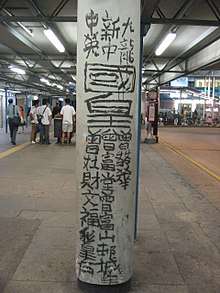 Street graffiti in Hong Kong
Street graffiti in Hong Kong The Graffiti Piece "Tante" (by Chen Dongfan) on the surface wall of an old residential building in Hangzhou, Zhejiang
The Graffiti Piece "Tante" (by Chen Dongfan) on the surface wall of an old residential building in Hangzhou, Zhejiang
Europe
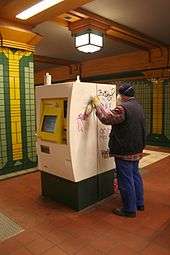
In Europe, community cleaning squads have responded to graffiti, in some cases with reckless abandon, as when in 1992 in France a local Scout group, attempting to remove modern graffiti, damaged two prehistoric paintings of bison in the Cave of Mayrière supérieure near the French village of Bruniquel in Tarn-et-Garonne, earning them the 1992 Ig Nobel Prize in archeology.[86]
In September 2006, the European Parliament directed the European Commission to create urban environment policies to prevent and eliminate dirt, litter, graffiti, animal excrement, and excessive noise from domestic and vehicular music systems in European cities, along with other concerns over urban life.[87]
The Anti-Social Behaviour Act 2003 became Britain's latest anti-graffiti legislation. In August 2004, the Keep Britain Tidy campaign issued a press release calling for zero tolerance of graffiti and supporting proposals such as issuing "on the spot" fines to graffiti offenders and banning the sale of aerosol paint to anyone under the age of 16.[88] The press release also condemned the use of graffiti images in advertising and in music videos, arguing that real-world experience of graffiti stood far removed from its often-portrayed 'cool' or 'edgy' image.
To back the campaign, 123 MPs (including then Prime Minister Tony Blair), signed a charter which stated: "Graffiti is not art, it's crime. On behalf of my constituents, I will do all I can to rid our community of this problem."[89]
In the UK, city councils have the power to take action against the owner of any property that has been defaced under the Anti-social Behaviour Act 2003 (as amended by the Clean Neighbourhoods and Environment Act 2005) or, in certain cases, the Highways Act. This is often used against owners of property that are complacent in allowing protective boards to be defaced so long as the property is not damaged.
In July 2008, a conspiracy charge was used to convict graffitists for the first time. After a three-month police surveillance operation,[90] nine members of the DPM crew were convicted of conspiracy to commit criminal damage costing at least £1 million. Five of them received prison sentences, ranging from eighteen months to two years. The unprecedented scale of the investigation and the severity of the sentences rekindled public debate over whether graffiti should be considered art or crime.[91]
Some councils, like those of Stroud and Loerrach, provide approved areas in the town where graffitists can showcase their talents, including underpasses, car parks, and walls that might otherwise prove a target for the 'spray and run.'[92]
In Budapest, Hungary, both a city-backed movement called I Love Budapest and a special police division tackle the problem, including the provision of approved areas.[93]
Australia

In an effort to reduce vandalism, many cities in Australia have designated walls or areas exclusively for use by graffitists. One early example is the "Graffiti Tunnel" located at the Camperdown Campus of the University of Sydney, which is available for use by any student at the university to tag, advertise, poster, and create "art". Advocates of this idea suggest that this discourages petty vandalism yet encourages artists to take their time and produce great art, without worry of being caught or arrested for vandalism or trespassing.[94][95] Others disagree with this approach, arguing that the presence of legal graffiti walls does not demonstrably reduce illegal graffiti elsewhere.[96] Some local government areas throughout Australia have introduced "anti-graffiti squads", who clean graffiti in the area, and such crews as BCW (Buffers Can't Win) have taken steps to keep one step ahead of local graffiti cleaners.
Many state governments have banned the sale or possession of spray paint to those under the age of 18 (age of majority). However, a number of local governments in Victoria have taken steps to recognize the cultural heritage value of some examples of graffiti, such as prominent political graffiti. Tough new graffiti laws have been introduced in Australia with fines of up to A$26,000 and two years in prison.
Melbourne is a prominent graffiti city of Australia with many of its lanes being tourist attractions, such as Hosier Lane in particular, a popular destination for photographers, wedding photography, and backdrops for corporate print advertising. The Lonely Planet travel guide cites Melbourne's street as a major attraction. All forms of graffiti, including sticker art, poster, stencil art, and wheatpasting, can be found in many places throughout the city. Prominent street art precincts include; Fitzroy, Collingwood, Northcote, Brunswick, St. Kilda, and the CBD, where stencil and sticker art is prominent. As one moves farther away from the city, mostly along suburban train lines, graffiti tags become more prominent. Many international artists such as Banksy have left their work in Melbourne and in early 2008 a perspex screen was installed to prevent a Banksy stencil art piece from being destroyed, it has survived since 2003 through the respect of local street artists avoiding posting over it, although it has recently had paint tipped over it.[97]
New Zealand

In February 2008 Helen Clark, the New Zealand prime minister at that time, announced a government crackdown on tagging and other forms of graffiti vandalism, describing it as a destructive crime representing an invasion of public and private property. New legislation subsequently adopted included a ban on the sale of paint spray cans to persons under 18 and increases in maximum fines for the offence from NZ$200 to NZ$2,000 or extended community service. The issue of tagging become a widely debated one following an incident in Auckland during January 2008 in which a middle-aged property owner stabbed one of two teenage taggers to death and was subsequently convicted of manslaughter.
United States

Tracker databases
Graffiti databases have increased in the past decade because they allow vandalism incidents to be fully documented against an offender and help the police and prosecution charge and prosecute offenders for multiple counts of vandalism. They also provide law enforcement the ability to rapidly search for an offender's moniker or tag in a simple, effective, and comprehensive way. These systems can also help track costs of damage to city to help allocate an anti-graffiti budget. The theory is that when an offender is caught putting up graffiti, they are not just charged with one count of vandalism; they can be held accountable for all the other damage for which they are responsible. This has two main benefits for law enforcement. One, it sends a signal to the offenders that their vandalism is being tracked. Two, a city can seek restitution from offenders for all the damage that they have committed, not merely a single incident. These systems give law enforcement personnel real-time, street-level intelligence that allows them not only to focus on the worst graffiti offenders and their damage, but also to monitor potential gang violence that is associated with the graffiti.[98]
Gang injunctions
Many restrictions of civil gang injunctions are designed to help address and protect the physical environment and limit graffiti. Provisions of gang injunctions include things such as restricting the possession of marker pens, spray paint cans, or other sharp objects capable of defacing private or public property; spray painting, or marking with marker pens, scratching, applying stickers, or otherwise applying graffiti on any public or private property, including, but not limited to the street, alley, residences, block walls, and fences, vehicles or any other real or personal property. Some injunctions contain wording that restricts damaging or vandalizing both public and private property, including but not limited to any vehicle, light fixture, door, fence, wall, gate, window, building, street sign, utility box, telephone box, tree, or power pole.[99]
Hotlines and reward programs
To help address many of these issues, many local jurisdictions have set up graffiti abatement hotlines, where citizens can call in and report vandalism and have it removed. San Diego's hotline receives more than 5,000 calls per year, in addition to reporting the graffiti, callers can learn more about prevention. One of the complaints about these hotlines is the response time; there is often a lag time between a property owner calling about the graffiti and its removal. The length of delay should be a consideration for any jurisdiction planning on operating a hotline. Local jurisdictions must convince the callers that their complaint of vandalism will be a priority and cleaned off right away. If the jurisdiction does not have the resources to respond to complaints in a timely manner, the value of the hotline diminishes. Crews must be able to respond to individual service calls made to the graffiti hotline as well as focus on cleanup near schools, parks, and major intersections and transit routes to have the biggest impact. Some cities offer a reward for information leading to the arrest and prosecution of suspects for tagging or graffiti related vandalism. The amount of the reward is based on the information provided, and the action taken.[100]
Search warrants
When the police use search warrants in connection with a vandalism investigation they are often seeking judicial approval to look for items such as cans of spray paint and nozzles from other kinds of aerosol sprays, etching tools, or other sharp or pointed objects used to etch or scratch glass and other hard surfaces, such as permanent marking pens and markers or paint sticks; evidence of membership or affiliation with any gang or tagging crew, paraphernalia to include any reference to "(tagger's name)," and any drawings, writings, objects, or graffiti depicting taggers' names, initials, logos, monikers, slogans, or mention of tagging crew membership; any newspaper clippings relating details of or referring to any graffiti crime.[101]
- Graffiti in the United States
 Rampant graffiti hampers visibility into and out of subway cars (1973)
Rampant graffiti hampers visibility into and out of subway cars (1973).jpg) Graffiti-lined tunnel in San Francisco
Graffiti-lined tunnel in San Francisco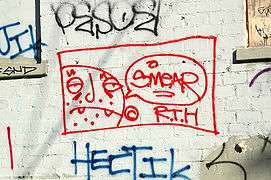 Graffiti in Los Angeles (2006)
Graffiti in Los Angeles (2006) Anti-governmental graffiti in Bolinas, California
Anti-governmental graffiti in Bolinas, California Protest art in Memphis, Tennessee
Protest art in Memphis, Tennessee
Documentaries
- 80 Blocks from Tiffany's (1979): A rare glimpse into late 1970s New York toward the end of the infamous South Bronx gangs, the documentary shows many sides of the mainly Puerto Rican community of the South Bronx, including reformed gang members, current gang members, the police, and the community leaders who try to reach out to them.
- Stations of the Elevated (1980), the earliest documentary about subway graffiti in New York City, with music by Charles Mingus
- Style Wars (1983), an early documentary on hip hop culture, made in New York City
- Piece by Piece (2005), a feature-length documentary on the history of San Francisco graffiti from the early 1980s
- Infamy (2005), a feature-length documentary about graffiti culture as told through the experiences of six well-known graffiti writers and a graffiti buffer
- NEXT: A Primer on Urban Painting (2005), a documentary about global graffiti culture
- RASH (2005), a feature documentary about Melbourne, Australia and the artists who make it a living host for street art
- Jisoe (2007): A glimpse into the life of a Melbourne, Australia, graffiti writer shows the audience an example of graffiti in struggling Melbourne Areas.
- Roadsworth: Crossing the Line (2009), about Montréal artist Peter Gibson and his controversial stencil art on public roads
- Exit Through The Gift Shop (2010) was produced by the notorious artist Banksy. It tells the story of Thierry Guetta, a French immigrant in Los Angeles, and his obsession with street art; Shepard Fairey and Invader, whom Guetta discovers is his cousin, are also in the film.
- Still on and non the wiser (2011) is a ninety-minute-long documentation that accompanies the exhibition with the same name in the Kunsthalle Barmen of the Von der Heydt-Museum in Wuppertal (Germany). It draws vivid portrayals of the artists by means of very personal interviews and also catches the creation process of the works before the exhibition was opened.[102]
- Graffiti Wars (2011), a documentary detailing King Robbo's feud with Banksy as well as the authorities' differing attitude towards graffiti and street art[103]
Dramas
- Wild Style (1983), about hip hop and graffiti culture in New York City
- Turk 182 (1985), about graffiti as political activism
- Bomb the System (2002), about a crew of graffitists in modern-day New York City
- Quality of Life (2004) was shot in the Mission District of San Francisco, co-written by and starring a retired graffiti writer.
- Wholetrain (2006), a German film
See also
- Anti-graffiti coating
- BUGA UP
- Calligraffiti
- The Faith of Graffiti
- Grafedia
- Graffiti abatement
- Graffiti post-2011 Egyptian Revolution
- Graffiti terminology
- Hobo sign
- Kilroy was here
- Kotwica
- Latrinalia
- List of graffiti and street art injuries and deaths
- Monsters of Art
- Philadelphia Mural Arts Program
- Spray paint art
- Stencil Graffiti
- Street art
- Vandalism
- Visual pollution
- Yarn bombing
References
- The Italian singular form "graffito" is so rare in English (except in specialist texts on archeology) that it is not even recorded or mentioned in some dictionaries, for example the Longman Dictionary of Contemporary English and the Cambridge Advanced Learner's Dictionary.
- "Graffiti". Oxford Dictionaries. Retrieved 2011-12-05.
- American Heritage Dictionary
- "Graffito". Oxford English Dictionary. 2. Oxford University Press. 2006.
- "Why Gang Graffiti Is Dangerous—Los Angeles Police Department". www.lapdonline.org. Retrieved 2018-02-19.
- Caves, R. W. (2004). Encyclopedia of the City. Routledge. p. 315.
- Grant, Alison (1983). North Devon Pottery: The Seventeenth Century. University of Exeter Press. pp. 1–2.
- "graffiti | Origin and meaning of graffiti by Online Etymology Dictionary". www.etymonline.com. Retrieved 2018-02-19.
- "How Old Is Graffiti?". Wonderopolis. Retrieved 24 January 2017.
- dan. "Ancient Arabia: Languages and Cultures—Safaitic Database Online". krc2.orient.ox.ac.uk. Retrieved 2018-02-19.
- dan. "The Online Corpus of the Inscriptions of Ancient North Arabia—Safaitic". krc.orient.ox.ac.uk. Retrieved 2018-02-19.
- Ancelet, Jeanine (2006). "The history of graffiti". UCL — London's Global University. Retrieved 20 Apr 2009.
- CIL IV, 4200 shows a failed attempt to write this little poem, maybe because the writer forgot the verses: see Todd, F. A. (1939). "Three Pompeian Wall-Inscriptions, and Petronius". The Classical Review. 53 (1): 5–9. doi:10.1017/S0009840X00088211. JSTOR 706251. page 6 note 2 and Bretschneider, L'Erma di (1990). Att Återupptäcka Pompeji. ISBN 9788870626865. page 39 note 85.
- Ponnamperuma, Senani (2013). Story of Sigiriya. Melbourne, Australia: Panique Pty Ltd. p. 157. ISBN 9780987345110.
- Paranavithana, Senarath (1956). Sigiri Graffiti; Being Sinhalese Verses of the Eighth, Ninth and Tenth Centuries. London: Govt. of Ceylon by Oxford UP.
- حسين مروّة، تراثنا كيف نعرفه، مؤسسة الأبحاث العربية، بيروت، 1986
- Olmert, Michael (1996). Milton's Teeth and Ovid's Umbrella: Curiouser & Curiouser Adventures in History. Simon & Schuster, New York. pp. 48–49. ISBN 978-0684801643.
- "Tacherons on Romanesque churches" (PDF).
- British Archaeology, June 1999
- "Underground Rome". The Atlantic Monthly. April 1997.
- "Independence Rock—California National Historic Trail (National Park Service)". National Park Service. Retrieved 18 January 2018.
- "Art Crimes". Jinx Magazine. Archived from the original on 2014-10-14.
- Shanks, Michael (1996). Classical Archaeology of Greece: Experiences of the Discipline. London, New York: Routledge. p. 76. ISBN 978-0-415-08521-2.
- Edwards, Paul (10 February 2015). "Is Graffiti Really An Element Of Hip-Hop? (book excerpt)". The Concise Guide to Hip-Hop Music. Retrieved 23 August 2018.
- Daniel, Bill (22 July 2010). "Who Is Bozo Texino?". Retrieved 23 August 2018.
- Daniel, Bill (2005). "Who Is Bozo Texino?". Who Is Bozo Texino? The Secret History of Hobo Graffiti. Retrieved 23 August 2018.
- Reagan, Geoffrey. Military Anecdotes (1992). Guinness Publishing. p. 33. ISBN 978-0-85112-519-0.
- "Words From a War". The New York Times. 14 August 1985. Retrieved 2 January 2017.
- Russell, Ross. Bird Lives!: The High Life And Hard Times Of Charlie (yardbird) Parker. Da Capo Press.
- "Hip Hop Meets Neue Deutsche Welle: Ja Ja Ja". Archived from the original on November 17, 2011.
- Labonte, Paul. All City: The book about taking space. Toronto. ECW Press. 2003
- David Hershkovits, "London Rocks, Paris Burns and the B-Boys Break a Leg", Sunday News Magazine, April 3, 1983.
- Ellis, Rennie (1985). The All New Australian Graffiti. Sun Books, Melbourne. ISBN 978-0-7251-0484-9.
- Niccolai, James (2001-04-19). "IBM's graffiti ads run afoul of city officials". CNN. Archived from the original on 2006-10-04. Retrieved 2006-10-11.
- "Sony Draws Ire With PSP Graffiti". Wired. 2005-12-05. Retrieved 2008-04-08.
- "Marc Ecko Hosts "Getting Up" Block Party For NYC Graffiti, But Mayor Is A Hater". SOHH.com. 2005-08-17. Archived from the original on 2006-10-04. Retrieved 2006-10-11.
- Ganz, Nicolas (2004). Graffiti World. Abrams, New York.
- Manco, Tristan (2005). Lost Art & Caleb Neelon, Graffiti Brazil. London: Thames and Hudson. pp. 7–10.
- "A força do novo grafite". Marie Claire (in Portuguese). Archived from the original on 29 November 2014. Retrieved 19 November 2014.
- "Nunca x Nike Sportswear "Team Brazil" Pack". Nicekicks.com. 2010-02-17.
- "Pintando o muro". Revelacaoonline.uniube.br. Archived from the original on 2011-05-01.
- Uleshka (19 January 2005). "A1one: 1st generation Graffiti in Iran". PingMag. Archived from the original on February 22, 2008.
- "Graffiti competition in Kuala Lumpur draws local and international artists". Khabar Southeast Asia. 2012-02-15. Archived from the original on 2012-11-13. Retrieved 2012-04-17.
- Ganz, Nicolas (2004). Graffiti World. New York. Abrams.
- "Hashtag on the pavement connects with Fitzrovia's past", Fitzrovia News, 23 July 2015, Retrieved 17 January 2016
- "#RISKROCK #GRAFFITI IN #SANFRANCISCO", Mass Appeal, Retrieved 17 January 2016.
- Karen Kurczynski (2008). Expression as vandalism: Asger Jorn's "Modifications". The University of Chicago Press. p. 293.
- Martin Thiele; Sally Marsden (2002-01-25). "P(ART)icipation and Social Change (.doc file)". Archived from the original (DOC) on 2005-06-15. Retrieved 2006-10-11.
- Banksy (2005). Wall and Piece. New York: Random House UK. ISBN 9781844137862.
- Shaer, Matthew (3 Jan 2007). "Pixnit Was Here". The Boston Globe. Retrieved 1 Mar 2009.
- "Crass Discography (Christ's reality asylum)". Southern Records. Archived from the original on 2006-09-12. Retrieved 2006-10-11.
- SFT: Ny dokumentär reder ut graffitins punkiga rötter Archived 2009-01-26 at the Wayback Machine. Dr Rat died in 1981 of an overdose at the age of 20 and was somewhat of an underground hero.
- Chang, Jeff (2005). Can't Stop Won't Stop: A History of the Hip-Hop Generation. New York: St. Martin's Press. p. 124. ISBN 978-0-312-30143-9.
- HARRINGTON, STEVEN. "Temporary Street Art That's Changing The Graffiti Game". Ziptopia. Retrieved 26 August 2018.
- English, Ron (6 Dec 2017). "Street Art: It's Not Meant to be Permanent". Huffington Post. Retrieved 26 August 2018.
- "Border Crossings". Village Voice. 2000-08-01. Archived from the original on 2006-11-07. Retrieved 2006-10-11.
- "Banksy". Tanya Baxter Contemporary Gallery. Retrieved 26 August 2018.
- "Banksy". Haynes Fine Art. Retrieved 26 August 2018.
- Ley, David; Roman Cybriwsky (Dec 1974). "Urban Graffiti as Territorial Markers".
- Halsey, M.; Young, A. (2002). "The Meanings of Graffiti and Municipal Administration". Australian and New Zealand Journal of Criminology. 35 (2): 165–86. doi:10.1375/acri.35.2.165.
- Holquist, M. (1981). "Glossary". In Bakhtin, M.M. (ed.). The Dialogic Imagination. Austin: University of Texas Press. p. 423.
- Kelling, G.; Coles, C. (1996). Fixing Broken Windows. New York: Martin Kessler Books.
- Barker, M. (1981). The New Racism. London: Junction Books.
- Lynn, Nick; Lea, Susan J. (2005). "'Racist' graffiti: text, context and social comment". Visual Communication. 4: 39–63. doi:10.1177/1470357205048935.
- Schreck, Carl (2015-06-19). "Russian politicians mocked with guerrilla pothole portraits". New East Network. Retrieved 2015-09-24.
- "Meet the man using penises to fill potholes". The Telegraph. 2015-04-29. Retrieved 2015-09-24.
- diallo, David (2014). "From the Street to Art Galleries : How Graffiti Became a Legitimate Art Form". Open Edition. Retrieved 26 August 2018.
- Morgan, Tiernan (August 6, 2015). "35 Years After Fashion Moda, a Bronx Gallery Revisits the Landmark Space". Hyperallergic. Retrieved 26 August 2018.
- HODARA, SUSAN (March 23, 2012). "When a South Bronx Collective Went International". New York Times. Retrieved 26 August 2018.
- SAMUELS, TANYANIKA (15 February 2013). "The legacy of Fashion Moda, a shuttered art and performance space, to be spotlighted". New York Daily News. Retrieved 26 August 2018.
- "Writing on the Wall". Time Out New York Kids. 2006. Archived from the original on 2006-11-13. Retrieved 2006-10-11.
- Smith, Bernard William; Smith, Terry; Heathcote, Christopher (2001). Australian Painting 1788–2000. Oxford University Press.
- "RFI—Graffiti gets into the Grand Palais". Rfi.fr. Retrieved 2010-07-29.
- Rohter, Larry (2009-03-30). "Toasting Graffiti Artists". The New York Times. Retrieved 2010-04-02.
- "KAWS". Interview Magazine. 2010-04-27.
- "Health and Environmental Issues of Spray Paint". Healthcare Environmental Resource Center. Retrieved 2019-04-30.
- Leskys, AM (September 2010). "Establishing Graffiti Emissions as a Nonpoint Source Sector" (PDF).
- "19th International Emission Inventory Conference "Emission Inventories—Informing Emerging Issues" September 2010". EPA.
- "In pictures: Graffiti artists in Beijing, Graffiti tradition". BBC NEWS.
- "Beijing's thriving graffiti culture may surprise you". Public Radio International. Retrieved 2019-04-24.
- Mo, Yan-chih (2007-08-13). "FEATURE: Taipei's graffiti artists strive for greater acceptance". Taipei Times. Retrieved 2011-01-16.
- "Taipei targets graffiti". Taipei Times. 8 June 2009. Retrieved 16 January 2011.
- Jennings, Ralph (2008-09-25). "Taiwan graffiti artist colors in legal gray area". Reuters. Retrieved 2011-01-16.
- Shenon, Philip (8 May 1994). "Singapore Swings; Michael Fay's Torture's Over; Watch for the Docudrama". New York Times. Retrieved 2010-04-02.
- Woo, Jaeyeon (31 May 2011). "Rat Graffiti Becomes a Political Stew". Korea Real Time (Wall Street Journal). Dow Jones & Company, Inc. Retrieved 6 June 2011.
- "1992 Ig Nobel Prize Winners". Archived from the original on 2011-02-25.
- "Thematic strategy on the urban environment — European Parliament resolution on the thematic strategy on the urban environment (2006/2061(INI))".
- "Graffiti" (Press release). EnCams.
- "Is the Writing on the Wall for Graffiti". PR News Wire. 2004-07-28.
- "Jail for leader of graffiti gang". BBC News. 2008-07-11. Retrieved 2008-07-17.
- Akbar, Arifa; Paul Vallely (2008-07-16). "Graffiti: Street art—or crime?". The Independent. London. Retrieved 2008-07-17.
- "Graffiti? Or is it Art?". BBC Gloucestershire.
- "Index—Belföld—Kommandó üldözi a graffitiseket". Index.hu. 2010-03-14. Retrieved 2010-07-29.
- "Legal Graffiti Wall Rules". Warringah Council. Archived from the original on August 21, 2006. Retrieved August 25, 2006.
- "Newcastle beach to get 'legal graffiti' wall". ABC News Online. 2005-05-25. Archived from the original on 2011-04-29. Retrieved 2018-12-09.
- "Against the wall". North Shore:Towns Online.com. 11 August 2006.
- "The painter painted: Melbourne loses its treasured Banksy". 2008-12-13. Retrieved 30 June 2009.
- "Chapter 8". Introduction to Criminal Investigation. Editor(s) Michael Birzer and Cliff Roberson.
- O'Deane, Matthew. "gang abatement". Gang Injunctions and Abatement: Using Civil Remedies to Curb Gang Related Crimes. Archived from the original on 2012-10-15. Retrieved 2011-05-21.
- O'Deane, Matthew. "gang". Gangs: Theory, Practice and Research. Archived from the original on 2016-03-05.
- O'Deane, Matthew. "gang". Gang Investigators Handbook.
- "News: Der Film zur Ausstellung" (in German). Von der Heydt-Museum. Retrieved May 23, 2013.
- "Graffiti Wars". 4od. Archived from the original on 2011-09-08.
Further reading
- Champion, Matthew (2017), "The Priest, the Prostitute, and the Slander on the Walls: Shifting Perceptions Towards Historic Graffiti", Peregrinations: Journal of Medieval Art and Architecture, 6 (1): 5–37

- Baird, J. A. and C. Taylor, eds. 2011, Ancient Graffiti in Context. New York: Routledge.
External links
| Look up graffiti in Wiktionary, the free dictionary. |
| Wikimedia Commons has media related to Graffiti. |
| Wikiquote has quotations related to: Graffiti |
- . New International Encyclopedia. 1905.
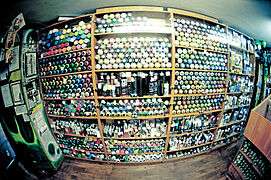
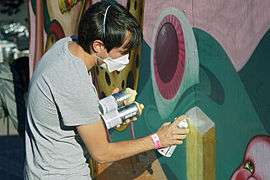
_CIMG9873.jpg)


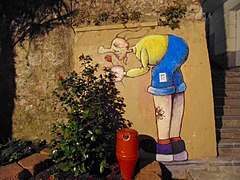
.jpg)
